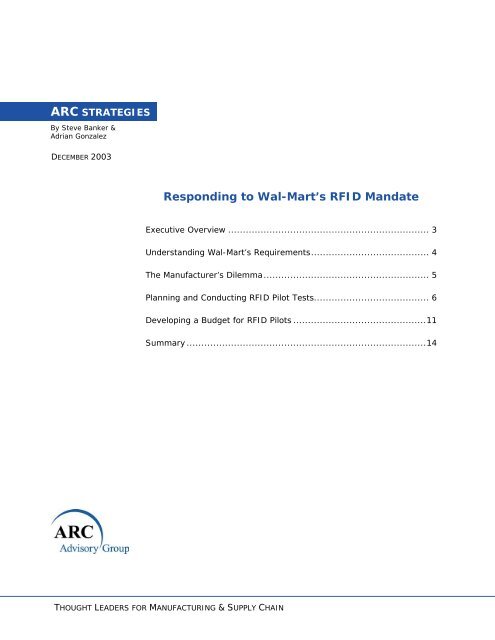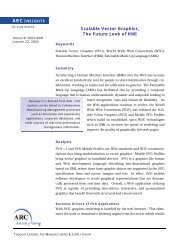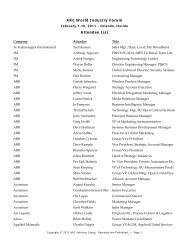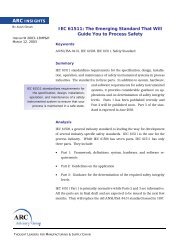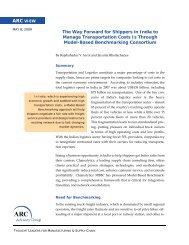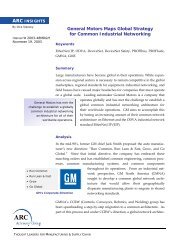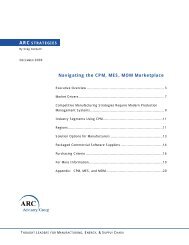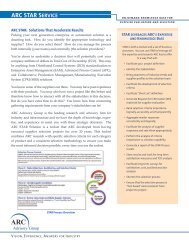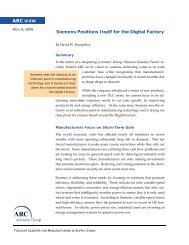Responding to Wal-Mart's RFID Mandate - ARC Advisory Group
Responding to Wal-Mart's RFID Mandate - ARC Advisory Group
Responding to Wal-Mart's RFID Mandate - ARC Advisory Group
You also want an ePaper? Increase the reach of your titles
YUMPU automatically turns print PDFs into web optimized ePapers that Google loves.
<strong>ARC</strong> STRATEGIES<br />
By Steve Banker &<br />
Adrian Gonzalez<br />
DECEMBER 2003<br />
<strong>Responding</strong> <strong>to</strong> <strong>Wal</strong>-Mart’s <strong>RFID</strong> <strong>Mandate</strong><br />
Executive Overview .................................................................... 3<br />
Understanding <strong>Wal</strong>-Mart’s Requirements........................................ 4<br />
The Manufacturer’s Dilemma........................................................ 5<br />
Planning and Conducting <strong>RFID</strong> Pilot Tests....................................... 6<br />
Developing a Budget for <strong>RFID</strong> Pilots .............................................11<br />
Summary .................................................................................14<br />
THOUGHT LEADERS FOR MANUFACTURING & SUPPLY CHAIN
<strong>ARC</strong> Strategies • December 2003<br />
What is your current activity with <strong>RFID</strong>?<br />
9.5%<br />
7.4%<br />
34.7%<br />
48.4%<br />
No activity<br />
Researching<br />
Piloting<br />
In production<br />
Source:<br />
Survey of 95 logistics executives at Global 1000 companies conducted by<br />
<strong>ARC</strong> <strong>Advisory</strong> <strong>Group</strong> and Richmond Events in May 2003.<br />
Almost 50 Percent of Companies Had No <strong>RFID</strong> Activity in May 2003<br />
(Before <strong>Wal</strong>-Mart’s Announcement)<br />
When do you expect <strong>to</strong> begin testing <strong>RFID</strong>?<br />
1.3%<br />
11.8%<br />
23.7%<br />
25.0%<br />
Next 12 mos.<br />
1-2 years<br />
3-5 years<br />
5+ years<br />
Never<br />
Source:<br />
38.2%<br />
Survey of 76 logistics executives at Global 1000 companies conducted by<br />
<strong>ARC</strong> <strong>Advisory</strong> <strong>Group</strong> and Richmond Events in May 2003<br />
Almost 40% of Respondents Didn’t Expect <strong>to</strong> Begin Testing <strong>RFID</strong><br />
Until at Least 2006<br />
2 • Copyright © <strong>ARC</strong> <strong>Advisory</strong> <strong>Group</strong> • <strong>ARC</strong>web.com
<strong>ARC</strong> Strategies • December 2003<br />
Executive Overview<br />
<strong>Wal</strong>-Mart has mandated that by January 2005 its <strong>to</strong>p 100 suppliers must<br />
apply passive <strong>RFID</strong> tags <strong>to</strong> cases and pallets shipped <strong>to</strong> specific distribution<br />
centers. Any <strong>Wal</strong>-Mart mandate has power because of its massive size -<br />
<strong>Wal</strong>-Mart is the largest retailer in the world ($244 billion in<br />
<strong>RFID</strong> is a Global event: sales in the last fiscal year, $41 billion from abroad). They are<br />
For example, both Marks and the largest seller of many categories of consumer goods - from<br />
Spenser in the UK and Tesco<br />
CDs, <strong>to</strong> prescription glasses, <strong>to</strong> over the counter pharmaceuticals,<br />
and many other areas. Virtually all manufacturers of<br />
in Germany, have also<br />
conducted very interesting<br />
consumer goods will eventually be impacted by this, particularly<br />
because <strong>Wal</strong>-Mart’s moves in <strong>RFID</strong> are being copied by<br />
pilots run of <strong>RFID</strong>.<br />
the Department of Defense and will soon be copied by other large retailers.<br />
As a result, a technology that was really one of the lowest rated interest areas<br />
in <strong>ARC</strong> surveys before the <strong>Wal</strong>-Mart mandate, has suddenly bubbled <strong>to</strong><br />
the <strong>to</strong>p.<br />
For most manufacturers, complying with this mandate will reduce profit<br />
margins, at least in the short term. But considering <strong>Wal</strong>-Mart’s overall contribution<br />
<strong>to</strong> revenues and profitability, non-compliance is generally not an<br />
option. Therefore, manufacturers must determine the most economic way<br />
<strong>to</strong> comply with this edict. Designing and conducting<br />
Manufacturers must determine<br />
pilot tests is a critical part of this process.<br />
the most economic way <strong>to</strong> comply<br />
with <strong>Wal</strong>-Mart’s edict. Designing<br />
The information in this report is meant <strong>to</strong> assist companies<br />
in outlining <strong>RFID</strong> pilot tests and creating associated<br />
and conducting pilot tests is a<br />
critical part of this process.<br />
budgets. The following <strong>to</strong>pics are discussed:<br />
• Overview <strong>Wal</strong>-Mart’s requirements (as disclosed <strong>to</strong> date);<br />
• Where and when <strong>to</strong> conduct pilot tests;<br />
• “Rules of thumb” for budget-related costs.<br />
This research was initiated in response <strong>to</strong> requests by members of <strong>ARC</strong>’s<br />
Logistics Executive Council (LEC). It complements other <strong>RFID</strong> reports produced<br />
by <strong>ARC</strong> and <strong>ARC</strong> will be conducting additional research on <strong>RFID</strong><br />
throughout 2004. Stay tuned!<br />
Copyright © <strong>ARC</strong> <strong>Advisory</strong> <strong>Group</strong> • <strong>ARC</strong>web.com • 3
<strong>ARC</strong> Strategies • December 2003<br />
Understanding <strong>Wal</strong>-Mart’s Requirements<br />
Suppliers will be required by January 2005 <strong>to</strong> ship <strong>RFID</strong>-tagged pallets and<br />
cases, with Electronic Product Codes (EPC), <strong>to</strong> three <strong>Wal</strong>-Mart distribution<br />
centers in Texas that support 150 different s<strong>to</strong>res, including Sam's Club,<br />
Sam's Market, and regular <strong>Wal</strong>-Mart outlets.<br />
All SKUs shipped <strong>to</strong> <strong>Wal</strong>-Mart must<br />
be tagged, but….<br />
% of SKUs<br />
% of<br />
Shipments<br />
…only three DCs will initially be able<br />
<strong>to</strong> receive tagged product; the<br />
uncertainty in ramp-up schedule<br />
makes planning very difficult.<br />
0% 20% 40% 60% 80% 100%<br />
The Uncertainty Surrounding the <strong>RFID</strong> Ramp Complicates Planning<br />
<strong>Wal</strong>-Mart will expand the number of distribution centers capable of receiving<br />
<strong>RFID</strong>-tagged product throughout 2005, but the ramp-up schedule is<br />
unknown. The company’s plans <strong>to</strong> implement <strong>RFID</strong> outside the United<br />
States is also vague.<br />
<strong>Wal</strong>-Mart continues <strong>to</strong> work closely with EPCglobal, a standards-setting<br />
organization focused on passive <strong>RFID</strong> and related technologies.<br />
Additional Requirements<br />
• Continued support of barcodes. Encoder/printers exist that can embed<br />
an <strong>RFID</strong> tag within a barcode label. Zebra is currently the only<br />
major hardware provider with this type of solution, but competitive of-<br />
4 • Copyright © <strong>ARC</strong> <strong>Advisory</strong> <strong>Group</strong> • <strong>ARC</strong>web.com
<strong>ARC</strong> Strategies • December 2003<br />
ferings from other suppliers are on the horizon. Get your orders in<br />
early - demand is outpacing supply.<br />
• Advanced Ship Notices (ASNs) must include EPC. <strong>Wal</strong>-Mart is currently<br />
modifying its ASN specification <strong>to</strong> make this possible.<br />
• Class 1/Version 2 tags will become the long-term standard. Class<br />
1/Version 2 standards should be finalized sometime next year. In the<br />
near term, Class 0 and Class 1/Version 1 EPC tags will be supported.<br />
Class 0 tags are programmed at the fac<strong>to</strong>ry; suppliers then need <strong>to</strong><br />
match the right tag <strong>to</strong> the<br />
right product before shipping.<br />
24-80 Specified<br />
<strong>Wal</strong>-Mart advises<br />
suppliers <strong>to</strong> buy “agile”<br />
64 Specified<br />
readers that can be upgraded<br />
via software <strong>to</strong> read new tag<br />
pro<strong>to</strong>cols. This is an endorsement<br />
of readers by<br />
EPC Tag Specifications<br />
ThingMagic and AWID.<br />
Class/Version MHz Type of Tag Bits Status<br />
Class 0 900-928 Fac<strong>to</strong>ry<br />
Programmable<br />
Class 0+ 900-928 Read/Write 24-80 Unspecified<br />
Class 1, v. 1 13.56 Write Once -<br />
Read Many<br />
Class 1, v. 2 860-930 Read/Write 64 Unspecified<br />
• Suppliers must scan <strong>RFID</strong> tags after they're applied <strong>to</strong> ensure they<br />
work. <strong>Wal</strong>-Mart expects suppliers <strong>to</strong> place one antenna on each side of<br />
a gateway or dock door and one antenna above. For case tagging and<br />
conveyors moving up <strong>to</strong> 600 feet per second, it expects one antenna on<br />
each side of the conveyor (or one antenna underneath and one above).<br />
Cases must be 100 percent readable for conveyors moving at 540 feet<br />
per second. EPCglobal is working on creating certification centers <strong>to</strong> allow<br />
suppliers <strong>to</strong> prove that all SKUs can be read, but the details on this<br />
are not fully hashed out. Computer supplier, Sun, is scheduled <strong>to</strong> have<br />
an <strong>RFID</strong> testing center open by the end of December in Dallas, Texas<br />
and another in Scotland in February of 2004.<br />
The Manufacturer’s Dilemma<br />
<strong>Wal</strong>-Mart has made it clear that it will not accept any price increases from<br />
suppliers related <strong>to</strong> <strong>RFID</strong> deployment, even though most (if not all) of the<br />
near-term benefits will be derived by the retailer. Achieving payback in<br />
less than three years will be very difficult for most manufacturers, particularly<br />
those with domestic supply chains.<br />
Copyright © <strong>ARC</strong> <strong>Advisory</strong> <strong>Group</strong> • <strong>ARC</strong>web.com • 5
<strong>ARC</strong> Strategies • December 2003<br />
The Retail Supply Chain and <strong>RFID</strong><br />
Transportation<br />
Retail<br />
DC<br />
Transportation<br />
S<strong>to</strong>re<br />
Backroom<br />
S<strong>to</strong>re<br />
Shelves<br />
Active <strong>RFID</strong> is<br />
used <strong>to</strong> track<br />
shipments from<br />
overseas, <strong>to</strong><br />
prove that<br />
shipments are<br />
secure, and <strong>to</strong><br />
speed cus<strong>to</strong>ms<br />
clearance<br />
Passive <strong>RFID</strong> is<br />
used <strong>to</strong> au<strong>to</strong>mate<br />
receiving & shipping;<br />
Barcodes for<br />
Putaway & Picking<br />
GPS or Wireless is<br />
used for<br />
tracking inven<strong>to</strong>ry<br />
in motion, active<br />
<strong>RFID</strong> can be used<br />
for tracking trailers<br />
in large yards<br />
Passive <strong>RFID</strong> is used <strong>to</strong><br />
receive at the s<strong>to</strong>re<br />
and <strong>to</strong> find inven<strong>to</strong>ry in<br />
the s<strong>to</strong>re back room, the<br />
use of “smart” shelves is<br />
a few years off for most<br />
retailers<br />
ROI Is More Compelling for Retailers<br />
Manufacturers with global supply chains, however, have a better chance of<br />
realizing benefits, but the implementation scope is more complex. Companies<br />
that import from Asia, for example, can track their goods from origin<br />
<strong>to</strong> destination using Supply Chain Event Management (SCEM) software<br />
coupled with active <strong>RFID</strong> tags on ocean containers, Global Positioning Systems<br />
(GPS) on ships and trucks, and passive <strong>RFID</strong> tags on pallets and cases.<br />
Having greater visibility in<strong>to</strong> “real time” events can lead<br />
The impact of <strong>RFID</strong> on business <strong>to</strong> reductions in inven<strong>to</strong>ry, less product obsolescence, and<br />
processes and supply chain<br />
other benefits that ultimately justify the investment in<br />
configurations remains <strong>to</strong> be<br />
<strong>RFID</strong> and other wireless technologies. Savi Technology<br />
seen, and it will be years before<br />
and Descartes Systems <strong>Group</strong> are leading solution providers<br />
in this area, but vendors like Manugistics and SAP<br />
case studies and best practices<br />
emerge.<br />
are also active.<br />
Nonetheless, the goal <strong>to</strong>day for most <strong>Wal</strong>-Mart suppliers is <strong>to</strong> determine<br />
the most cost-effective way <strong>to</strong> comply with the retailer’s mandate. Designing<br />
and conducting pilot tests is a critical part of this process.<br />
Planning and Conducting <strong>RFID</strong> Pilot<br />
Tests<br />
It’s important for companies <strong>to</strong> remember that using passive <strong>RFID</strong> technology<br />
and EPC for supply chain management purposes is still relatively new.<br />
The impact of this technology on business processes and supply chain configurations<br />
remains <strong>to</strong> be seen, and it will be years before case studies and<br />
best practices emerge.<br />
At this stage of the game, learning about the technology and conducting<br />
pilot tests should be the primary focus. The information gathered from<br />
6 • Copyright © <strong>ARC</strong> <strong>Advisory</strong> <strong>Group</strong> • <strong>ARC</strong>web.com
<strong>ARC</strong> Strategies • December 2003<br />
these tests can be used <strong>to</strong> develop Return on Investment (ROI) models and<br />
it can help answer key questions such as:<br />
• When should the tags be applied, as part of the packaging process or at<br />
the distribution center before shipping?<br />
• Should the tagging process be done internally or handled by external<br />
partners such as co-packers or third party logistics providers (3PLs)?<br />
• What impact would changes in ramp-up schedule have on these decisions?<br />
As with all initiatives of this nature, assembling a cross-functional team is<br />
very important. Team members must include high-level managers that<br />
understand manufacturing and fulfillment process flows. Internal experts<br />
on <strong>RFID</strong> (if they exist) should also be included, along with representatives<br />
from IT, finance, material handling, and industrial engineering (for<br />
time/motion studies).<br />
Timing Your <strong>RFID</strong> Investments<br />
The conventional advice is that companies should start investing and piloting<br />
<strong>RFID</strong> as soon as possible. In some respects, this is good advice. There<br />
is likely <strong>to</strong> be a shortage of consultants with strong capabilities in EPC<br />
<strong>RFID</strong>. However, there are three good reasons <strong>to</strong> wait until at least the middle<br />
of 2004 <strong>to</strong> begin active tests.<br />
• Early implementers will be the guinea pigs. EPC <strong>RFID</strong> consulting expertise<br />
does not exist. The early adopters will effectively serve as the<br />
training ground for consultants. Therefore, companies that wait will<br />
have access <strong>to</strong> more experienced consultants and obtain insight in<strong>to</strong> the<br />
successes and failures of the early adopters.<br />
• Despite the availability of agile readers, companies that invest early<br />
may have <strong>to</strong> replace <strong>RFID</strong> hardware down the road. The specification<br />
standards for Class 1/Version 2 tags have not been finalized. <strong>RFID</strong><br />
providers like Matrics, Alien Technologies, AWOD, and Thing Magic<br />
have the early lead when it comes <strong>to</strong> EPC <strong>RFID</strong>. However, the longer a<br />
company waits before investing in hardware, the more finalized the<br />
standards become and the more choices they’ll have in suppliers, as established<br />
companies like Symbol, Intermec, Texas Instruments, and<br />
Siemens introduce their own solutions.<br />
Copyright © <strong>ARC</strong> <strong>Advisory</strong> <strong>Group</strong> • <strong>ARC</strong>web.com • 7
<strong>ARC</strong> Strategies • December 2003<br />
• The volume ramp-up is not yet unders<strong>to</strong>od. <strong>Wal</strong>-Mart has not disclosed<br />
how quickly it plans <strong>to</strong> roll out <strong>RFID</strong> across its entire distribution<br />
network. It’s also unclear what the other major retailers plan <strong>to</strong> do.<br />
Since the overall ramp-up schedule will have an impact on where <strong>to</strong> do<br />
the tagging, the longer companies wait, the clearer the ramp-up rate<br />
will become.<br />
For suppliers of both <strong>Wal</strong>-Mart and the Department of<br />
For suppliers of both <strong>Wal</strong>-Mart<br />
Defense (DOD), the latter may help subsidize the investment<br />
in <strong>RFID</strong>. The DoD will not finalize its <strong>RFID</strong><br />
and the Department of Defense<br />
(DOD), the latter may help<br />
requirements until July 2004, but it appears that they will<br />
subsidize the investment in <strong>RFID</strong>.<br />
follow <strong>Wal</strong>-Mart’s lead and support Class 1/Version 2<br />
tags, as well as the yet-<strong>to</strong>-be developed Class 2 standards.<br />
The DoD has ten classes of suppliers. Many <strong>Wal</strong>-Mart suppliers fall in<strong>to</strong><br />
Class VI (personal demand items) and Class 1/Version 2 tags will likely<br />
suffice for this category. While <strong>Wal</strong>-Mart will not <strong>to</strong>lerate price increases<br />
stemming from <strong>RFID</strong>, the DoD cannot do the same. The DoD has preexisting<br />
contracts in place, many of them multi-year deals, and so it will have <strong>to</strong><br />
pay higher prices for tagged items.<br />
<strong>Wal</strong>-Mart’s <strong>to</strong>p 100 suppliers are not on the DoD’s <strong>to</strong>p 500 list; hence, they<br />
don’t need <strong>to</strong> comply with the DoD’s mandate until January 2006 (a year<br />
later than <strong>Wal</strong>-Mart’s deadline). But if these companies comply with the<br />
DoD mandate early, they can amortize the cost of their <strong>RFID</strong> investments<br />
across a larger volume. Also, the DoD will be subsidizing the effort by paying<br />
higher prices. Similar logic applies if other retailers issue their own<br />
<strong>RFID</strong> edicts that require standardization on Class 1/Version 2 tags.<br />
Where and When <strong>to</strong> Tag<br />
Companies have two basic options with regards <strong>to</strong> when <strong>to</strong> apply the tags:<br />
• As part of the packaging process, most likely in a highly-au<strong>to</strong>mated<br />
manner;<br />
• As part of the fulfillment process, most likely in a manual manner.<br />
Since many companies outsource their packaging and fulfillment operations<br />
<strong>to</strong> co-packers and 3PLs, they will need <strong>to</strong> work closely with these<br />
partners <strong>to</strong> plan and execute <strong>RFID</strong> tests.<br />
8 • Copyright © <strong>ARC</strong> <strong>Advisory</strong> <strong>Group</strong> • <strong>ARC</strong>web.com
<strong>ARC</strong> Strategies • December 2003<br />
Making the transition from<br />
the DC <strong>to</strong> the plant depends<br />
on several fac<strong>to</strong>rs, including<br />
number of SKUs, percent of<br />
shipping volume, and<br />
number of cus<strong>to</strong>mers that<br />
require <strong>RFID</strong> tags.<br />
Plant<br />
Where <strong>to</strong><br />
Tag?<br />
DC<br />
The decision also<br />
requires a firm<br />
understanding of the<br />
costs associated<br />
with each option, as<br />
well as the impact<br />
on processes.<br />
Low<br />
?<br />
Volume<br />
High<br />
If a service provider is doing <strong>Wal</strong>-Mart compliance work for several cus<strong>to</strong>mers,<br />
outsourcing may be a more cost-effective option in the long run.<br />
However, manufacturers must still develop a clear understanding of the<br />
cost implications of the different options, especially costs associated with<br />
process changes.<br />
At low volumes, tagging at the distribution center is probably the best option.<br />
But when volumes reach a certain critical level, au<strong>to</strong>mating the<br />
tagging process and incorporating it as part of the packaging operation may<br />
be justified. Part of the challenge is determining the critical volume threshold<br />
for this scenario, thus the importance of having a firm understanding of<br />
costs and process implications, and the importance of conducting pilots<br />
both at the fac<strong>to</strong>ry and the distribution center.<br />
Considerations and Strategies for the DC Pilot<br />
• A company’s WMS will be used <strong>to</strong> route SKUs that need <strong>RFID</strong> tags <strong>to</strong><br />
special tag application and verification scanning locations. While this<br />
could be done at receiving, most companies will choose <strong>to</strong> do this after<br />
picking.<br />
• Some SKUs (with metal or liquid content) may have <strong>to</strong> use nonstandard<br />
tags and will need <strong>to</strong> be routed <strong>to</strong> different <strong>RFID</strong> encoding stations.<br />
Copyright © <strong>ARC</strong> <strong>Advisory</strong> <strong>Group</strong> • <strong>ARC</strong>web.com • 9
<strong>ARC</strong> Strategies • December 2003<br />
• Instead of outfitting every dock door with readers, a single gateway<br />
with readers can be constructed. Pallets are driven through the gateway<br />
before they’re taken <strong>to</strong> their designated door. Fewer readers are<br />
required with this configuration.<br />
• Costs depend on whether it is an older WMS, legacy solution, or a<br />
modern WMS. Modern WMS solutions support the work flows described<br />
above.<br />
• Older WMS and legacy solutions do not support the workflows described<br />
above and thus may require cus<strong>to</strong>mization (est. $50,000).<br />
• WMS solutions often use RF devices. Older RF systems that operate in<br />
the 900 Mhz range may need <strong>to</strong> be replaced because they will cause<br />
reader interference.<br />
• The key drawback of doing this in the DC is wasted labor. Cases are<br />
palletized at the fac<strong>to</strong>ry, then depalletized at the DC <strong>to</strong> enable tagging,<br />
then repalletized.<br />
• The key benefit is that warehouse personnel are use <strong>to</strong> Value Added<br />
Service processes, fac<strong>to</strong>ry personnel are not.<br />
Considerations and Strategies for the Fac<strong>to</strong>ry Pilot<br />
• Case tags are applied at high speed, in line, on a fac<strong>to</strong>ry production line<br />
conveyor. The barcode/encoder must be <strong>to</strong>ld which items require<br />
which tags (bar code, barcode + <strong>RFID</strong>, or more expensive bar code<br />
<strong>RFID</strong> tags with larger antennas).<br />
• The tag/bar code applica<strong>to</strong>r should be able <strong>to</strong> apply tags <strong>to</strong> different<br />
size and shaped packages and apply the tag on a specific location on the<br />
case/car<strong>to</strong>n <strong>to</strong> insure that it can be read reliably.<br />
• When tags are applied at the DC, the actual ship <strong>to</strong> locations are<br />
known. Because of manufacturing lead times, tags may have <strong>to</strong> be applied<br />
in the fac<strong>to</strong>ry before it is known exactly how many of a certain<br />
SKU will need <strong>RFID</strong> tags. Err on the high side! Apply more tags than<br />
are needed, perhaps 10 <strong>to</strong> 20 percent more than are forecast.<br />
• Many of <strong>Wal</strong>-Mart’s <strong>to</strong>p suppliers participate in Collaborative Planning<br />
Forecasting and Replenishment (CPFR) or VMI programs. These processes,<br />
in conjunction with the Sales and Operations Planning (S&OP)<br />
10 • Copyright © <strong>ARC</strong> <strong>Advisory</strong> <strong>Group</strong> • <strong>ARC</strong>web.com
<strong>ARC</strong> Strategies • December 2003<br />
process, will supply the replenishment data used <strong>to</strong> drive the allocation<br />
process. These processes may need <strong>to</strong> be adjusted. Replenishment order<br />
data will now need <strong>to</strong> be fed <strong>to</strong> the fac<strong>to</strong>ry’s Production<br />
Management system.<br />
• A key drawback <strong>to</strong> doing this in the fac<strong>to</strong>ry is that the <strong>RFID</strong> tagged<br />
cases will need <strong>to</strong> be segregated and handled differently from the other<br />
cases. This is a fundamentally different process in many fac<strong>to</strong>ries.<br />
• A key benefit, if tags are applied at the fac<strong>to</strong>ry, receiving and shipping<br />
processes can be au<strong>to</strong>mated in the DCs.<br />
Developing a Budget for <strong>RFID</strong> Pilots<br />
Conducting <strong>RFID</strong> pilots requires an investment in people, hardware, software,<br />
and consulting services. This section provides some “rules of thumb”<br />
for costing these fac<strong>to</strong>rs. A basic pilot test at a distribution center (one facility,<br />
one gateway with three readers, and several thousand tags) will likely<br />
cost in the neighborhood of $500,000 (not including internal employee costs<br />
devoted <strong>to</strong> this project). A pilot test at a fac<strong>to</strong>ry can be twice as expensive,<br />
considering the high cost of sortation systems.<br />
100%<br />
80%<br />
60%<br />
40%<br />
20%<br />
0%<br />
5%<br />
70%<br />
15%<br />
10%<br />
Training<br />
Consulting<br />
Software<br />
Hardware<br />
Avg. Pilot Costs<br />
$500K for<br />
DC Pilot<br />
$1M for<br />
Fac<strong>to</strong>ry Pilot<br />
Consulting Services Is Biggest Contribu<strong>to</strong>r <strong>to</strong> Cost<br />
Copyright © <strong>ARC</strong> <strong>Advisory</strong> <strong>Group</strong> • <strong>ARC</strong>web.com • 11
<strong>ARC</strong> Strategies • December 2003<br />
Consulting<br />
There are several different categories of consultants that will be competing<br />
for business:<br />
• Supply Chain Execution (SCE) companies such as Manhattan Associates,<br />
RedPrairie, Provia, HighJump, ClearOrbit, and Acsis.<br />
• Global consulting firms like IBM, CGEY, Deloitte, and Accenture.<br />
• New best of breed <strong>RFID</strong> suppliers, both hardware and software, like<br />
Alien Technologies, AWID, GlobeRanger, and Matrics<br />
• Material handling suppliers like Siemens Dematic, SwissLog, HK Systems,<br />
and SK Daifuku.<br />
• ERP suppliers are beginning <strong>to</strong> devote attention <strong>to</strong> <strong>RFID</strong> as well. While<br />
their solutions have yet <strong>to</strong> take on any real, implemental form, suppliers<br />
such as SAP, Oracle, Peoplesoft, and SSA will be players within a two<br />
year timeframe.<br />
Companies should assign a single consultant <strong>to</strong> serve as the lead implementer<br />
so that if something goes wrong they know who <strong>to</strong> hold accountable.<br />
The best-of-breed <strong>RFID</strong> hardware suppliers have the best EPC <strong>RFID</strong> expertise,<br />
but these suppliers lack broad deployment teams and project<br />
management expertise. <strong>ARC</strong> believes SCE suppliers have a strong value<br />
proposition for DC pilots, while global consultants and high-end material<br />
handling firms are best suited for fac<strong>to</strong>ry pilots.<br />
Different types of consulting expertise are required. Some of these must be<br />
done in sequence, others can be done concurrently.<br />
• Product Readiness – What types of <strong>RFID</strong> tags will different SKUs need?<br />
Where on the case or pallet should the tag be placed?<br />
• Site Readiness – Does your warehouse use an RF system that operates<br />
in the 900 Mhz range and interferes with the current EPC <strong>RFID</strong> tags?<br />
Where should gateways be placed so that interference does not occur<br />
• Application Expertise - <strong>RFID</strong> needs <strong>to</strong> be integrated with Warehouse<br />
Management, Production Management, ERP, and EDI solutions. How<br />
well do the consultants understand these applications?<br />
12 • Copyright © <strong>ARC</strong> <strong>Advisory</strong> <strong>Group</strong> • <strong>ARC</strong>web.com
<strong>ARC</strong> Strategies • December 2003<br />
• Business Process Expertise – The ability <strong>to</strong> map “as is” and “<strong>to</strong> be”<br />
processes is important. Understanding how processes like CPFR or<br />
S&OP may need <strong>to</strong> be modified is also critical.<br />
• Material Handling Expertise – The ability <strong>to</strong> provide high speed<br />
placement of tags on fast moving conveyor belts.<br />
• Project Management – The ability <strong>to</strong> do systems analysis, scope definition,<br />
and phasing.<br />
• Industrial Engineering - Time and motion studies should be done before<br />
and after the pilots <strong>to</strong> develop a strong understanding of how <strong>RFID</strong><br />
affects ongoing operational costs. The best of these consultants combine<br />
this work with a bottleneck analysis. Speeding activities through<br />
non-bottlenecked operations does not always save money.<br />
Hardware<br />
• $30,000 for readers, printers, and server. One standalone gateway with<br />
three readers ( $5,000); one hand-held reader with accessories ($4,000);<br />
one Class 1 <strong>RFID</strong> label printer/encoder and workstation ($10,000);<br />
maintenance contracts (about $1,000). If a company has multiple SKUs<br />
that require special tags (such as liquid and metal products), an additional<br />
encoder will be necessary. One server, about $10,000.<br />
• Tags currently cost between 15 cents in an order quantities of a million<br />
<strong>to</strong> about 50 cents in quantities of a thousand. For certain SKUs,<br />
nonstandard tags will need <strong>to</strong> be used and these will be more expensive.<br />
Middleware<br />
• $15,000 <strong>to</strong> $150,000 for middleware. Price depends on whether the<br />
middleware is Savant middleware used <strong>to</strong> filter and connect hardware<br />
<strong>to</strong> application software, Trading Partner Management middleware that<br />
forwards EPC codes in an ASN format <strong>to</strong> trading partners, or both.<br />
Copyright © <strong>ARC</strong> <strong>Advisory</strong> <strong>Group</strong> • <strong>ARC</strong>web.com • 13
<strong>ARC</strong> Strategies • December 2003<br />
Training<br />
• $15,000 <strong>to</strong> $25,000 for training and education. Following these kinds of<br />
projects, most project managers will tell you they wish they had spent<br />
more on training.<br />
Summary<br />
There is certainly a lot of hype surrounding <strong>RFID</strong>, but now that <strong>Wal</strong>-Mart<br />
and the DoD have issued mandates, companies can no longer ignore this<br />
trend. Although retailers will enjoy most of the near-term benefits, manufacturers<br />
have <strong>to</strong> find a way <strong>to</strong> not only comply with these mandates, but<br />
also derive benefits as well.<br />
Although retailers will enjoy most<br />
of the near-term benefits, Learning about the technology and conducting pilot tests<br />
manufacturers have <strong>to</strong> find a way<br />
should be the primary focus at this stage of the game.<br />
<strong>to</strong> not only comply with these<br />
The information gathered from these tests can be used <strong>to</strong><br />
mandates, but also derive<br />
develop ROI models and answer important questions<br />
benefits as well.<br />
such as where and when <strong>to</strong> do the tagging.<br />
At low volumes, tagging at the DC is probably the best option. But when<br />
volumes reach a certain critical level, au<strong>to</strong>mating the tagging process and<br />
incorporating it as part of the packaging operation may be justified. Part of<br />
the challenge is determining the critical volume threshold for this scenario,<br />
thus the importance of having a firm understanding of costs and process<br />
implications, and the importance of conducting pilots both at the fac<strong>to</strong>ry<br />
and the DC.<br />
The other challenge, particularly for <strong>Wal</strong>-Mart’s <strong>to</strong>p 100 suppliers, is balancing<br />
the need <strong>to</strong> move quickly in order <strong>to</strong> meet the January 2005<br />
deadline, and the inclination <strong>to</strong> wait as long as possible in order <strong>to</strong> leverage<br />
developing expertise and allow some of the uncertainties <strong>to</strong> fade away.<br />
It will take some time for case studies and best practices <strong>to</strong> emerge. The<br />
more information that companies can share with regards <strong>to</strong> successes and<br />
pitfalls, the faster this technology will be adopted and bring benefits <strong>to</strong> all.<br />
<strong>ARC</strong> will continue <strong>to</strong> research this <strong>to</strong>pic and serve as a medium for industry<br />
collaboration and knowledge transfer.<br />
14 • Copyright © <strong>ARC</strong> <strong>Advisory</strong> <strong>Group</strong> • <strong>ARC</strong>web.com
<strong>ARC</strong> Strategies • December 2003<br />
Analyst: Steve Banker, Adrian Gonzalez<br />
Edi<strong>to</strong>r: John Moore<br />
Distribution: All EAS & LEC Clients<br />
Acronym Reference: For a complete list of industry acronyms, refer <strong>to</strong> our<br />
web page at www.arcweb.com/Community/terms/terms.htm<br />
3PL Third Party Logistics<br />
API Application Program Interface<br />
ASN Advanced Shipping Notice<br />
B2B Business-<strong>to</strong>-Business<br />
BPM Business Process Management<br />
CAGR Compound Annual Growth Rate<br />
CAS Collaborative Au<strong>to</strong>mation System<br />
CMM Collaborative Manufacturing<br />
Management<br />
CNC Computer Numeric Control<br />
CPG Consumer Packaged Goods<br />
CPAS Collaborative Process Au<strong>to</strong>mation<br />
System<br />
CPFR Collaborative Planning, Forecasting<br />
and Replenishment<br />
DC Distribution Center<br />
EDI Electronic Data Interchange<br />
EPC Electronic Product Code<br />
ERP Enterprise Resource Planning<br />
GPS Global Positioning Satellite<br />
IT Information Technology<br />
LAN Local Area Network<br />
MIS Management Information System<br />
MRP Materials Resource Planning<br />
OpX Operational Excellence<br />
OLE Object Linking & Embedding<br />
OPC OLE for Process Control<br />
PAS Process Au<strong>to</strong>mation System<br />
RF Radio Frequency<br />
<strong>RFID</strong> Radio Frequency Identification<br />
ROI Return on Investment<br />
S&OP Sales & Operational Planning<br />
SCE Supply Chain Execution<br />
SKU S<strong>to</strong>ck Keeping Unit<br />
VMI Vendor Managed Inven<strong>to</strong>ry<br />
WMS Warehouse Management System<br />
Founded in 1986, <strong>ARC</strong> <strong>Advisory</strong> <strong>Group</strong> has grown <strong>to</strong> become the Thought<br />
Leader in Manufacturing and Supply Chain solutions. For even your most complex<br />
business issues, our analysts have the expert industry knowledge and<br />
firsthand experience <strong>to</strong> help you find the best answer. We focus on simple,<br />
yet critical goals: improving your return on assets, operational performance,<br />
<strong>to</strong>tal cost of ownership, project time-<strong>to</strong>-benefit, and shareholder value.<br />
<strong>ARC</strong> Strategies is published monthly by <strong>ARC</strong>. All information in this report is<br />
proprietary <strong>to</strong> and copyrighted by <strong>ARC</strong>. No part of it may be reproduced without<br />
prior permission from <strong>ARC</strong>.<br />
You can take advantage of <strong>ARC</strong>'s extensive ongoing research plus experience<br />
of our staff members through our <strong>Advisory</strong> Services. <strong>ARC</strong>’s <strong>Advisory</strong> Services<br />
are specifically designed for executives responsible for developing strategies<br />
and directions for their organizations. For subscription information, please<br />
call, fax, or write <strong>to</strong>:<br />
<strong>ARC</strong> <strong>Advisory</strong> <strong>Group</strong>, Three Allied Drive, Dedham, MA 02026 USA<br />
Tel: 781-471-1000, Fax: 781-471-1100, Email: info@<strong>ARC</strong>web.com<br />
Visit our web page at <strong>ARC</strong>web.com<br />
Copyright © <strong>ARC</strong> <strong>Advisory</strong> <strong>Group</strong> • <strong>ARC</strong>web.com • 15
3 ALLIED DRIVE DEDHAM MA 02026 USA 781-471-1000<br />
BOSTON, MA | PITTSBURGH, PA | PHOENIX, AZ | SAN FRANCISCO, CA<br />
CAMBRIDGE, U.K. | Düsseldorf, GERMANY | MUNICH, GERMANY | HAMBURG, GERMANY | TOKYO, JAPAN | BANGALORE, INDIA


